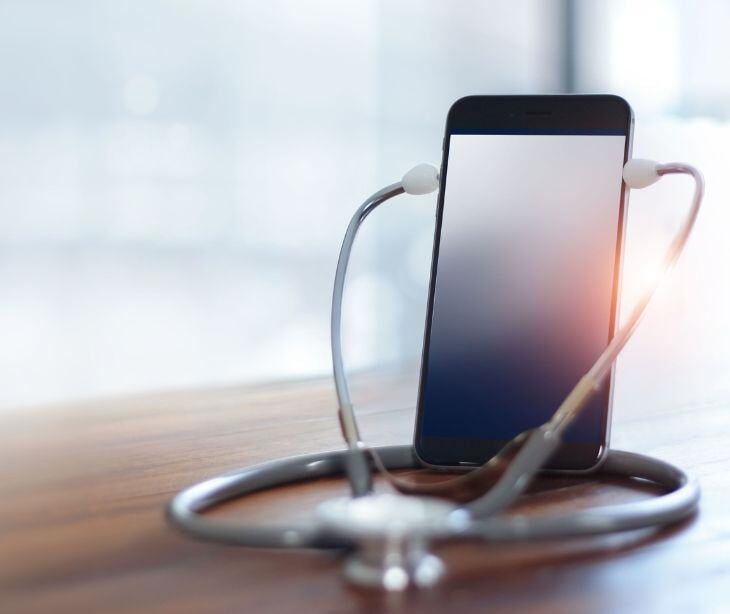4 min read
Integrating HIPAA compliant texting in your healthcare organization
Tshedimoso Makhene
April 06, 2024

The inclusion of HIPAA compliant text messaging allows healthcare organizations to use a modern and safe communication channel. This integration yields enhanced efficiency, improved care coordination, and enhanced patient engagement.
The need for secure communication in healthcare
Effective communication provides timely and coordinated care for patients. Healthcare professionals need to exchange information such as test results, treatment plans, and medication orders securely and efficiently to provide patients with quality healthcare services. However, traditional communication methods like phone calls and emails may not be as efficient for receiving a timely response.
Unsecured texting or messaging apps may inadvertently expose patient data to unauthorized individuals, potentially leading to HIPAA violations and compromising patient trust. Recognizing these risks, healthcare organizations increasingly turn to HIPAA compliant text messaging solutions to ensure secure communication while adhering to regulatory requirements.
Introducing Paubox Texting
Paubox Texting is a HIPAA compliant texting API for patient engagement. With Paubox Texting, covered entities send HIPAA compliant text messages directly to their recipients' mobile devices without the recipient having to download third-party applications or use passcode-protected portals.
The Paubox Texting API offers healthcare providers and organizations the ability to personalize text with PHI and directly engage with the patient, all of this while being HIPAA compliant and encrypting messages to keep PHI safe.
Learn more:Introducing HIPAA compliant texting API by Paubox
Benefits of HIPAA compliant text messaging
The prevalence of text messages (or SMS - short message service) in healthcare settings is increasingly accepted, with more than 85% of doctors and nurses having smartphones or tablets and between 60 to 80% of them using these devices to exchange patient care-related texts. “Many clinical staff prefer text messages over other communication methods such as e-mail and paging. 6 The mobility of SMS communication, 7 better integration into workflow, ability to communicate more clearly and efficiently, ease of use, perception of improved efficiency and communication with other clinical staff, and actual improved workflow efficiency are commonly cited reasons for the popularity of SMS in clinical care.”
Integrating HIPAA compliant text messaging offers several benefits for healthcare organizations, including:
- Enhanced efficiency: HIPAA compliant text messaging allows healthcare professionals to communicate quickly and efficiently, streamlining care coordination and improving workflow efficiency.
- Improved care coordination: Secure messaging enables healthcare teams to collaborate effectively, facilitating real-time communication among physicians, nurses, and other care providers. This leads to better coordination of care and improved patient outcomes.
- Patient engagement: Text messaging offers a convenient and accessible means of communication for patients, allowing them to receive appointment reminders, follow-up instructions, and other important information securely.
- Enhanced security: HIPAA compliant text messaging platforms employ encryption and security measures to protect patient data from unauthorized access, ensuring compliance with HIPAA regulations.
- Reduced risk of compliance violations: By adopting a HIPAA compliant messaging solution, healthcare organizations mitigate the risk of HIPAA violations associated with unsecured communication methods, safeguarding patient privacy and avoiding costly penalties.
See also: HIPAA compliant texting for patient-centered communication
Integrating HIPAA compliant text messaging
Integrating HIPAA compliant text messaging into existing healthcare systems can be a strategic investment in patient care and data security. By seamlessly incorporating secure messaging capabilities into electronic health record (EHR) systems and other clinical communication platforms, healthcare organizations can realize a multitude of benefits while maintaining compliance with regulatory requirements.
Here are some things healthcare providers and organizations must consider when integrating HIPAA compliant text messaging with their current communication channels:
API integration and interoperability
One of the approaches to integrating HIPAA compliant text messaging is through API integration or interoperability with existing healthcare systems. By leveraging application programming interfaces (APIs), healthcare organizations can seamlessly connect their EHR systems and clinical communication platforms with HIPAA compliant messaging solutions. This allows for the seamless exchange of patient information while ensuring data security and compliance with HIPAA regulations.
Collaboration with IT departments and vendors
Successful integration of HIPAA compliant text messaging requires close collaboration between healthcare organizations, IT departments, and healthcare technology vendors. IT professionals implement and configure the necessary infrastructure to support secure messaging capabilities. Healthcare technology vendors, on the other hand, provide the expertise and solutions needed to ensure compliance with regulatory requirements.
Ensuring seamless integration and compliance
Healthcare organizations must prioritize functionality and compliance when integrating HIPAA compliant text messaging. This involves conducting thorough assessments of existing systems, identifying potential integration points, and working closely with IT teams and vendors to implement seamless solutions. Furthermore, healthcare organizations must ensure that the chosen messaging platform meets the stringent security and privacy standards mandated by HIPAA.
Steps to Integrate HIPAA compliant text messaging
Integrating HIPAA compliant text messaging into a healthcare organization requires careful planning and implementation. Here are the key steps to follow:
- Conduct a risk assessment: Assess the current communication methods and identify potential vulnerabilities that may compromise patient data security.
- Select a HIPAA compliant messaging platform: Choose a secure messaging platform specifically designed for healthcare that meets HIPAA standards and offers features such as encryption, message recall, and authentication.
- Train staff on HIPAA compliance: Provide comprehensive training to healthcare professionals on HIPAA regulations and secure communication practices, emphasizing the importance of patient privacy and confidentiality.
- Develop policies and procedures: Establish clear policies and procedures for using the messaging platform in compliance with HIPAA regulations, including guidelines for sending and receiving sensitive information securely.
- Obtain patient consent: Inform patients about the use of text messaging for communication and obtain their consent before sending any sensitive information via text.
- Implement security measures: Encrypt devices used for accessing the messaging platform, enforce strong password policies, and enable features like remote wiping for lost or stolen devices to enhance security.
- Monitor and audit usage: Regularly monitor and audit the use of the messaging platform to ensure compliance with policies and regulations, and address any security incidents promptly.
- Maintain ongoing compliance: Stay updated on changes to HIPAA regulations, regularly review and update policies, conduct continuous staff training, and perform security audits to maintain compliance.
FAQs
Are there any limitations to be aware of when using HIPAA compliant text messaging?
While HIPAA compliant text messaging offers many benefits, healthcare organizations should be aware of limitations such as potential technical glitches, the need for staff training and education, and the importance of ongoing monitoring and maintenance to ensure continued compliance and security.
Can patients request copies of text messages containing their health information?
Patients have the right to request copies of their health information, including text messages containing their medical records or communications with healthcare providers. Healthcare organizations should have procedures in place for fulfilling patient requests for access to their health information in compliance with HIPAA regulations.
Related:
Are there any specific requirements for storing text messages containing patient information?
Healthcare organizations must adhere to HIPAA regulations regarding the storage and retention of electronic communications containing patient information. Text messages should be securely stored according to HIPAA guidelines, and organizations should have policies in place for retaining and disposing of messages when they are no longer needed.
Subscribe to Paubox Weekly
Every Friday we'll bring you the most important news from Paubox. Our aim is to make you smarter, faster.




